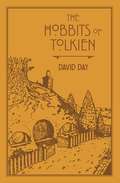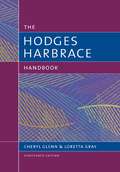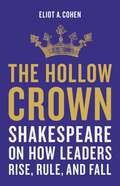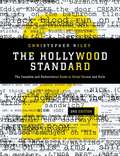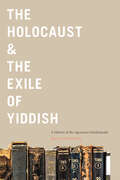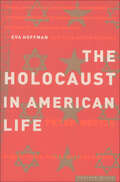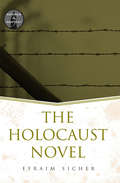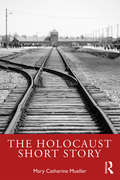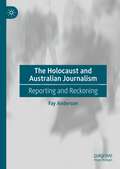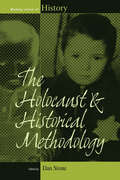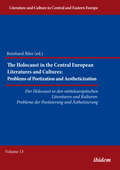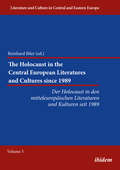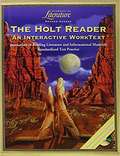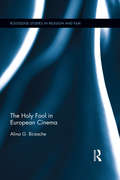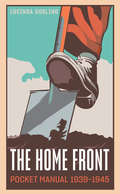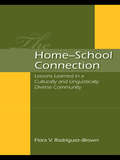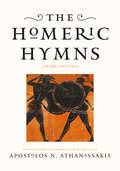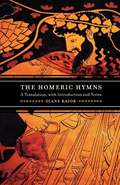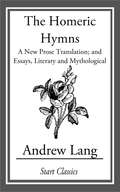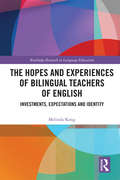- Table View
- List View
The Hobbits of Tolkien: An Illustrated Exploration of Tolkien's Hobbits, and the Sources that Inspired his Work from Myth, Literature and History (Tolkien Illustrated Guides #6)
by David DayAn entire race was born when J.R.R. Tolkien scrawled on a leaf, 'In a hole in the ground there lived a hobbit.' From the invention of that single word (hobbit) Tolkien became the explorer and chronicler of the character, their race and their significant role in his fantastical world, Middle-earth.Here in his latest book, Tolkien expert David Day unpicks the myriad of riddles, puns and mystical meanings in Tolkien's works; The Hobbit and The Lord of the Rings.
The Hodges Harbrace Handbook (19th Edition)
by Cheryl Glenn Loretta GrayImprove your writing skills with THE HODGES HARBRACE HANDBOOK, 19th Edition! Learn how to write effectively, choose the best information, arrange it well, and use the most appropriate language when writing for a particular audience. This grammar-first handbook provides complete coverage of writing essentials to help you develop the skills you need to be a successful college writer, including grammar, style, punctuation, mechanics, writing, and research.
The Hollow Crown: Shakespeare on How Leaders Rise, Rule, and Fall
by Eliot A. CohenWhat Shakespeare&’s plays can teach us about modern-day politics William Shakespeare understood power: what it is, how it works, how it is gained, and how it is lost. In The Hollow Crown, Eliot A. Cohen reveals how the battling princes of Henry IV and scheming senators of Julius Caesar can teach us to better understand power and politics today. The White House, after all, is a court—with intrigue and conflict rivaling those on the Globe&’s stage—as is an army, a business, or a university. And each court is full of driven characters, in all their ambition, cruelty, and humanity. Henry V&’s inspiring speeches reframe John F. Kennedy&’s appeal, Richard III&’s wantonness illuminates Vladimir Putin&’s brutality, and The Tempest&’s grace offers a window into the presidency of George Washington. An original and incisive perspective, The Hollow Crown shows how Shakespeare&’s works transform our understanding of the leaders who, for good or ill, make and rule our world.
The Hollywood Standard: The Complete and Authoritative Guide to Script Format and Style (2nd edition)
by Christopher Riley"The Hollywood Standard" describes, in clear, vivid prose and hundreds of examples, how to format every element of a screenplay or television script. A reference for everyone who writes for the screen, from the novice to the veteran, this is the dictionary of script format, with instructions for formatting everything from the simplest master scene heading to the most complex and challenging musical underwater dream sequence. This new edition includes a quick start guide, plus new chapters on avoiding a dozen deadly formatting mistakes, clarifying the difference between a spec script and production script, and mastering the vital art of proofreading. For the first time, readers will find instructions for formatting instant messages, text messages, email exchanges and caller ID.
The Holocaust & the Exile of Yiddish: A History of the Algemeyne Entsiklopedye
by Barry TrachtenbergIn the early 1930s in Berlin, Germany, a group of leading Eastern European Jewish intellectuals embarked upon a project to transform the lives of millions of Yiddish-speaking Jews around the world. Their goal was to publish a popular and comprehensive Yiddish language encyclopedia of general knowledge that would serve as a bridge to the modern world and as a guide to help its readers navigate their way within it. However, soon after the Algemeyne entsiklopedye (General Encyclopedia) was announced, Hitler’s rise to power forced its editors to flee to Paris. The scope and mission of the project repeatedly changed before its final volumes were published in New York City in 1966. The Holocaust & the Exile of Yiddish untangles the complicated saga of the Algemeyne entsiklopedye and its editors. The editors continued to publish volumes and revise the encyclopedia’s mission while their primary audience, Eastern European Jews, faced persecution and genocide under Nazi rule, and the challenge of reestablishing themselves in the first decades after World War II. Historian Barry Trachtenberg reveals how, over the course of the middle decades of the twentieth century, the project sparked tremendous controversy in Jewish cultural and political circles, which debated what the purpose of a Yiddish encyclopedia should be, as well as what knowledge and perspectives it should contain. Nevertheless, this is not only a story about destruction and trauma, but also one of tenacity and continuity, as the encyclopedia’s compilers strove to preserve the heritage of Yiddish culture, to document its near-total extermination in the Holocaust, and to chart its path into the future.
The Holocaust In American Life
by Peter NovickThis “courageous and thought-provoking book” examines how the Holocaust came to hold its unique place in American memory (Foreign Affairs).Prize–winning historian Peter Novick explores in absorbing detail the decisions that moved the Holocaust to the center of American life. He illuminates how Jewish leaders invoked its memory to muster support for Israel, and how politicians in turn used it to score points with Jewish voters. With insight and sensitivity, Novick raises searching questions about these developments, their meaning, and their consequences. Does the Holocaust really teach useful lessons and sensitize us to atrocities, or, by making the Holocaust the measure, does it make lesser crimes seem “not so bad”? Have American Jews, by making the Holocaust the emblematic Jewish experience, given Hitler a posthumous victory, tacitly endorsing his definition of Jews as despised pariahs? What are we to make of the fact that while Americans spend hundreds of millions of dollars for museums recording a European crime, while comparatively little is done to memorialize American slavery?A New York Times Notable Book
The Holocaust Novel (Genres in Context)
by Efraim SicherThe first comprehensive study of Holocaust literature as a major postwar literary genre, The Holocaust Novel provides an ideal student guide to the powerful and moving works written in response to this historical tragedy. This student-friendly volume answers a dire need for readers to understand a genre in which boundaries and often blurred between history, fiction, autobiography, and memoir. Other essential features for students here include an annotated bibliography, chronology, and further reading list. Major texts discussed include such widely taught works as Night, Maus, The Shawl, Schindler's List, Sophie's Choice, White Noise, and Time's Arrow.
The Holocaust Short Story
by Mary Catherine MuellerThe Holocaust Short Story is the only book devoted entirely to representations of the Holocaust in the short story genre. The book highlights how the explosiveness of the moment captured in each short story is more immediate and more intense, and therefore recreates horrifying emotional reactions for the reader. The main themes confronted in the book deal with the collapse of human relationships, the collapse of the home, and the dying of time in the monotony and angst of surrounding death chambers. The book thoroughly introduces the genres of both the short story and Holocaust writing, explaining the key features and theories in the area. Each chapter then looks at the stories in detail, including work by Ida Fink, Tadeusz Borowski, Rokhl Korn, Frume Halpern, and Cynthia Ozick. This book is essential reading for anyone working on Holocaust literature, trauma studies, Jewish studies, Jewish literature, and the short story genre.
The Holocaust and Australian Journalism: Reporting and Reckoning
by Fay AndersonThis book explores the Australian press reporting of the persecution and genocide of European Jews, and the extent to which the news of the Holocaust was known and believed, revealed and hidden, and acknowledged and minimised. Spanning the coverage of Hitler’s political ascent in the 1920s through to the Nazis’ extermination campaign, it culminates in the accounts of the trials of Nazi war criminals and the post-war transnational migration to Australia of Holocaust survivors, to a country far from universally welcoming in its reception of them. The book also tells the story of the journalists who reported on these tragic events and the editors who published them, along with the political, social and cultural context in which they worked, in an environment influenced by exclusionary ideas about race and nationality that did not necessarily inspire sympathy for Jews and their trauma. This book sheds light on the ethics of reporting human suffering, violence and genocide and – centrally – on the role of the press in shaping Australia’s collective memory of the Holocaust. It encourages readers to think critically about media power, public apathy, advocacy, and the importance of truth. Disturbing evidence of increasing anti-Semitism in Australia as elsewhere, along with continuing Holocaust denial, provide an additional urgency to this study.
The Holocaust and Historical Methodology
by Dan StoneIn the last two decades our empirical knowledge of the Holocaust has been vastly expanded. Yet this empirical blossoming has not been accompanied by much theoretical reflection on the historiography. This volume argues that reflection on the historical process of (re)constructing the past is as important for understanding the Holocaust-and, by extension, any past event-as is archival research. It aims to go beyond the dominant paradigm of political history and describe the emergence of methods now being used to reconstruct the past in the context of Holocaust historiography.
The Holocaust in Central European Literatures and Cultures: Problems of Poetization and Aestheticization
by Reinhard IblerRelating the Holocaust to poetic and aesthetic phenomena has often been considered taboo, as only authentic testimony, documents, or at least 'unliterary', prosaic approaches were seen as appropriate. However, from the very beginning of Holocaust literature and culture, there were tendencies towards literarization, poetization, and ornamentalization. Nowadays, aesthetic approaches-also in provocative, taboo-breaking ways-are more and more frequently encountered and seen as important ways to evoke the attention required to keep the cataclysm alive in popular memory. The essays in this volume use examples predominantly from Polish, Czech, and German Holocaust literature and culture to discuss this controversial subject. Topics include the poetry of concentration camp detainees, lyrical poetry about the Holocaust, poetic tendencies in narrative literature and drama, ornamental prose about the Holocaust, and the devices and functions of aestheticization in Holocaust literature and culture.
The Holocaust in Central European Literatures and Cultures: Problems of Poetization and Aestheticization (Literature and Culture in Central and Eastern Europe #13)
by Reinhard IblerRelating the Holocaust to poetic and aesthetic phenomena has often been considered taboo, as only authentic testimony, documents, or at least 'unliterary', prosaic approaches were seen as appropriate. However, from the very beginning of Holocaust literature and culture, there were tendencies towards literarization, poetization, and ornamentalization. Nowadays, aesthetic approaches—also in provocative, taboo-breaking ways—are more and more frequently encountered and seen as important ways to evoke the attention required to keep the cataclysm alive in popular memory. The essays in this volume use examples predominantly from Polish, Czech, and German Holocaust literature and culture to discuss this controversial subject. Topics include the poetry of concentration camp detainees, lyrical poetry about the Holocaust, poetic tendencies in narrative literature and drama, ornamental prose about the Holocaust, and the devices and functions of aestheticization in Holocaust literature and culture.
The Holocaust in the Central European Literatures and Cultures since 1989: Der Holocaust in den mitteleuropäischen Literaturen und Kulturen seit 1989
by Reinhard Ibler Aleksandra Bak-Zawalski Katharina Bauer Sascha Feuchert Grzegorz Gazda Anja Golebiowski Elisa-Maria Hiemer Jiri Holy Hana Hribkova Agnieszka Izdebska Danuta Szajnert Valentina Kaptayn Malgorzata Leyko Markus Roth Wolfgang Schwarz Marija Sruk Filip Tomas Tereza Tomasova Hans-Christian Trepte Olga ZitovaThis insightful book assembles a great variety of contributions on the literature and culture of the Holocaust since 1989. Focusing on Poland, the Czech Republic, and Germany, what becomes apparent is that the Nazi genocide continues to be a pivotal issue in literature, theatre, and film. Including overviews of the literary and cultural developments of the last decades, the chapters cover a wide variety of authors of both the older and younger generation such as Ruth Klüger, Roma Ligocka, Leon Weliczker, Andrzej Bart, Marek Bienczyk, and Magdalena Tulli. The growing use of provocative and taboo-breaking forms of expression turns out to be an important instrument in keeping alive the memory of the horrible events in the collective memory.
The Holocaust in the Central European Literatures and Cultures since 1989: Der Holocaust in den mitteleuropäischen Literaturen und Kulturen seit 1989 (Literature and Culture in Central and Eastern Europe #5)
by Reinhard Ibler Aleksandra Bak-Zawalski Katharina Bauer Sascha Feuchert Grzegorz Gazda Anja Golebiowski Elisa-Maria Hiemer Jiri Holy Hana Hribkova Agnieszka Izdebska Danuta Szajnert Valentina Kaptayn Malgorzata Leyko Markus Roth Wolfgang Schwarz Marija Sruk Filip Tomas Tereza Tomasova Hans-Christian Trepte Olga ZitovaThis insightful book assembles a great variety of contributions on the literature and culture of the Holocaust since 1989. Focusing on Poland, the Czech Republic, and Germany, what becomes apparent is that the Nazi genocide continues to be a pivotal issue in literature, theatre, and film. Including overviews of the literary and cultural developments of the last decades, the chapters cover a wide variety of authors of both the older and younger generation such as Ruth Klüger, Roma Ligocka, Leon Weliczker, Andrzej Bart, Marek Bienczyk, and Magdalena Tulli. The growing use of provocative and taboo-breaking forms of expression turns out to be an important instrument in keeping alive the memory of the horrible events in the collective memory.
The Holt Reader: An Interactive WorkText, Grade 8 Second Course (Elements of Literature)
by Winston Staff Rinehart Holt<p>Imagine this. A book full of stories you want to read and informational articles that are really interesting. Make it a book that actually tells you to write in it, circling, underlining, jotting down responses. Fill it with graphic organizers that encourage you to think a different way. Make it a size that's easy to carry around. That's <i>The Holt Reader: An Interactive WorkText</i>--a book created especially for you. <p><i>The Holt Reader: An Interactive WorkText</i> is designed to accompany Elements of Literature. Like Elements of Literature, it's designed to help you interact with the literature and informational materials you read.
The Holy Fool in European Cinema (Routledge Studies in Religion and Film)
by Alina G. BirzacheThis monograph explores the way that the profile and the critical functions of the holy fool have developed in European cinema, allowing this traditional figure to capture the imagination of new generations in an age of religious pluralism and secularization. Alina Birzache traces the cultural origins of the figure of the holy fool across a variety of European traditions. In so doing, she examines the critical functions of the holy fool as well as how filmmakers have used the figure to respond to and critique aspects of the modern world. Using a comparative approach, this study for the first time offers a comprehensive explanation of the enduring appeal of this protean and fascinating cinematic character. Birzache examines the trope of holy foolishness in Soviet and post-Soviet cinema, French cinema, and Danish cinema, corresponding broadly to and permitting analysis of the three main orientations in European Christianity: Orthodox, Catholic, and Protestant. This study will be of keen interest to scholars of religion and film, European cinema, and comparative religion.
The Home Front Pocket Manual, 1939–1945 (The\pocket Manual Ser.)
by Lucinda GoslingThis compilation of WWII-era magazine articles is &“a really useful reference guide covering aspects of life in the 1940s . . . packed with information&” (Home Front History). This manual brings together articles from stylish contemporary magazines of Britain during the World War II era, including Britannia & Eve, the Illustrated Sporting and Dramatic News, and Tatler, on all aspects of life on the home front. These fascinating articles cover complying with black-out regulations; what to do with the family car; augmenting rationed foods and turning them into tasty meals; contributing to the war effort by keeping livestock, salvaging valuable materials, and growing food—all, of course, while remaining fashionable and keeping up appearances.
The Home-School Connection: Lessons Learned in a Culturally and Linguistically Diverse Community
by Flora V. Rodriguez-Brown"In this unique contribution to the literature on parental involvement in culturally and linguistically diverse communities, Flora Rodríguez-Brown offers a critique of family literacy programs that lack a clear design for literacy activities relevant to community goals, offering an alternative model that is grounded within an abiding respect for the parents’ role as the child’s first, and ultimately, most important teacher." Robert D. Milk, University of Texas, San Antonio The Project FLAME program used as context for this book is a comprehensive family literacy model, supported by a strong sociocultural framework based on current research on cultural ways of learning and theories of multiliteracies and discourse. The model highlights the relevance of parents’ knowledge, cultural ways, and discourses in sharing literacy knowledge with their children. A pressing need exists for models and programs that effectively serve the educational needs of the steadily increasing numbers of culturally and linguistically diverse students in U.S. public schools today. Addressing issues related to development, implementation, and effectiveness of a program model that fulfills this need, this book is an essential resource for educators, community workers, and researchers interested in the relevance of the home-school connection in relation to children’s school success.
The Home-based Bookstore: Start Your Own Business Selling Used Books on Amazon, Ebay or Your Own Web Site
by Steve WeberShows you how to open a used bookstore and sell on amazon.com, ebay.com, or other sites, with a concentration on amazon.com. Discusses where to find books, good business practices, and tools that can help you with your book business.
The Homeric Hymns
by Apostolos N. AthanassakisA rich source for students of Greek mythology and literature, the Homeric Hymns are also fine poetry. Attributed by the ancients to Homer, these prooimia, or preludes, were actually composed by various poets over centuries. They were performed at religious festivals as entertainment meant to stir up enthusiasm for far more ambitious compositions that followed them, namely the Iliad and Odyssey. Each of the thirty-three poems is written in honor of a Greek god or goddess. Together, the hymns provide a fascinating view into the ancients' view of deities. In this long-awaited third edition of his acclaimed translations of the hymns, Apostolos Athanassakis preserves the vigor and the magic of the ancient text while modernizing traditional renditions of certain epithets and formulaic phrases. He avoids lengthening or truncating lines, thereby crafting a symmetrical text, and makes an effort to keep to an iambic flow without sacrificing accuracy. Athanassakis enhances his classic work with a new index of names and topics, updated bibliography, revised genealogical charts, and careful and selective changes in the translations themselves. An expanded introduction addresses ancient reception of the hymns. Numerous additions to the notes, reflecting over twenty-five years of scholarship, draw on modern anthropological and archaeological research to explore prominent themes and religious syncretism within the poems. These materials all enrich the reader's experience of these ancient and influential poems.A perennial classroom favorite, The Homeric Hymns embodies thrilling new visions of antiquity.
The Homeric Hymns
by Diane RayorThe Homeric Hymns have survived for two and a half millennia because of their captivating stories, beautiful language, and religious significance. Well before the advent of writing in Greece, they were performed by traveling bards at religious events, competitions, banquets, and festivals. Thirty-four poems that invoke and celebrate the gods of ancient Greece, the Homeric Hymns raise questions that humanity still struggles with--questions about our place among others and in the world. "Homeric" because they were composed in the same meter, dialect, and style as Homer's Iliad and Odyssey, these "hymns" were created to be sung aloud. In this superb translation by Diane Rayor, which deftly combines accuracy and poetry, the ancient music of the hymns comes alive for the modern reader. Here is the birth of Apollo, god of prophecy, healing, and music and founder of Delphi, the most famous oracular shrine in ancient Greece. Here is Zeus, inflicting upon Aphrodite her own mighty power to cause gods to mate with humans, and here is Demeter rescuing her daughter Persephone from the underworld and initiating the rites of the Eleusinian Mysteries. With her introduction and notes, Rayor places the hymns in their historical and aesthetic context, providing all the information needed to read, interpret, and fully appreciate these literary windows on an ancient world. As introductions to the Greek gods, entrancing stories, exquisite poetry, and early literary records of key religious rituals and sites, The Homeric Hymns should be read by any student of mythology, classical literature, ancient religion, women in antiquity, or the Greek language.
The Homeric Hymns: A New Prose Translation; and Essays, Literary and Mythological
by Andrew LangAndrew Lang (1844-1912) was a prolific Scots man of letters, a poet, novelist, literary critic and contributor to anthropology. He now is best known as the collector of folk and fairy tales. He was educated at the Edinburgh Academy, St Andrews University and at Balliol College, Oxford. As a journalist, poet, critic and historian, he soon made a reputation as one of the ablest and most versatile writers of the day. Lang was one of the founders of the study of "Psychical Research," and his other writings on anthropology include The Book of Dreams and Ghosts (1897), Magic and Religion (1901) and The Secret of the Totem (1905). He was a Homeric scholar of conservative views. Other works include Homer and the Epic (1893); a prose translation of The Homeric Hymns (1899), with literary and mythological essays in which he draws parallels between Greek myths and other mythologies; and Homer and his Age (1906). He also wrote Ballades in Blue China (1880) and Rhymes la Mode (1884).
The Honeysuckle and the Hazel Tree: Medieval Stories of Men and Women
by Patricia TerryKnown for her fine translations of octosyllabic narrative verse, Patricia Terry presents translations of four major practitioners of this dominant literary form of twelfth- and thirteenth-century France. Her introduction discusses the varying views of women and love in the texts and their place in the courtly tradition.From Chrétien de Troyes Terry includes an early work, Philomena, here translated into verse for the first time. The other great writer of this period was Marie de France, the first woman in the European narrative tradition. Lanval is newly translated for this edition, which also features four of Marie's other poems. The collection further includes The Reflection by Jean Renart, known for his realistic settings; and the anonymous Chatelaine of Vergi, a fatalistic and perhaps more modern depiction of love.
The Hopes and Experiences of Bilingual Teachers of English: Investments, Expectations and Identity (Routledge Research in Language Education)
by Melinda KongIn this age of internationalisation of higher education, many bilingual teachers from non-English-speaking contexts pursue their postgraduate degrees in English-speaking countries. Most programmes focus on providing content knowledge to them, while neglecting their investments. Furthermore, not much attention is given to what these bilingual teachers expect to gain from studying abroad, as well as their lived experiences and identity construction both inside and outside the classroom in English-speaking countries and when they return home. Nevertheless, these dimensions are crucial to their growth as teachers and users of English. This book explores these neglected aspects through case studies of bilinguals from various backgrounds. Through these case studies, the book examines the hopes, struggles and adaptation of bilinguals. It provides insights into what international students should realistically expect when studying overseas, and how to empower bilingual teachers, users and learners of English.
The Horizontal World: Growing Up Wild in The Middle of Nowhere
by Debra MarquartIn the tradition of John McPhee and Kathleen Norris, a wry, moving memoir about a family farm, a father, and a daughter, and how you can't not go home again.
